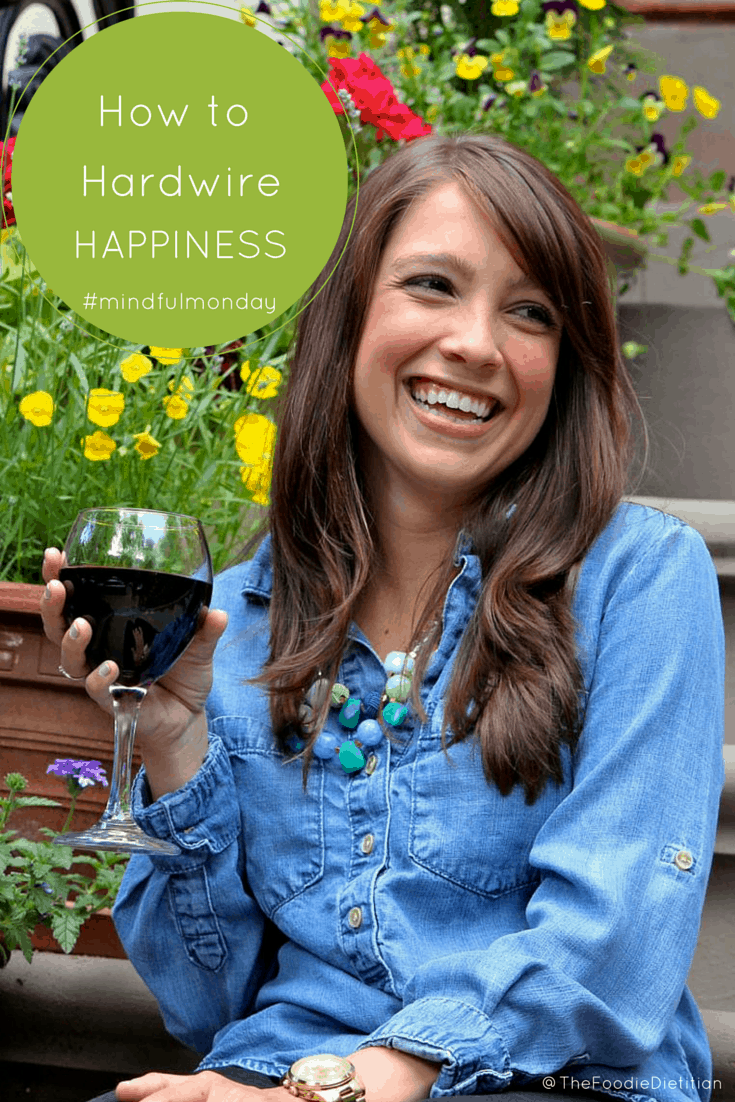A simple acronym can actually teach you how to hardwire happiness – hardwiring your brain for more positive thinking and experiences.

During my yoga teacher training, I became curious about meditation. I really enjoyed the action of carving out space for myself and took interest in learning different techniques and types of meditation. And then 5 months passed since my teacher training and I missed having that same interest and curiosity level that I had during the training. I wanted to take my meditation practice to the next level and learn more about the scientific benefits of this practice so I signed up for an 8-week mindfulness and meditation course at South Boston Yoga.
I’m half way through the course now and soaking up every minute of it. I’m learning a lot about my personal practice and meditation in general and I look forward to sharing my learnings with you on Mindful Mondays. Today, I wanted to share something that’s fresh in my mind as I just watched this TedX video my meditation teacher sent the class. The talk is called “Hardwiring Happiness” given by Neuropsychologist and Author Dr. Rick Hanson.
The context of the video is based on a concept coined by neuroscientists that we talked about in my meditation course – “Neurons that fire together, wire together. Passing mental states become lasting mental traits.” Meaning that your habitual thoughts can actually change your brain structure to become programmed for certain responses and reactions to situations.
So, how do you get the inner strengths we all desire (like confidence, happiness, feeling loved, positive emotions, executive functioning) into the brain? Most of these inner strengths are built from positive experiences of those strengths. For example, if you want to have a more loving heart, practice more experiences of showing compassion for others.
Sounds fairly simple, right? So, why do we struggle with this?
Our brains have a hardwired negativity bias – our brains are really great at learning from bad experiences but not so great at learning from good experiences. So, our good experiences bounce off the brain, while our bad experiences sink in. And we can thank our ancestors for this bias – they had to pay a lot of attention to bad news in order to survive.
So how do we overcome this negativity bias? We have to learn to let the good experiences sink into the fabric of our brain and our lives.
Dr. Hanson recommends using the acronym HEAL to remember how to hardwire the brain for happiness:
Have a good experience.
Enrich the experience (let it last, let it grow, become more intense).
Absorb it (sense that it is sinking into you).
Link the positive experience with something negative (this last step is optional – and you have to be cautious that the negative doesn’t overcome. The ideas is the positive can go into the negative to soothe it and eventually replace it).
Try practicing this right now! Think about a person that really cares about you (in an effort to try to have a good experience of feeling cared about). Let this memory or image turn into a feeling, an experience. And then stay with it and let it sink in for about 20 seconds or so.
How do you feel?
By repeating this activity of letting good experiences sink in over and over again, you’ll start to overcome that negativity bias and the neurons that fire and wire together will be based on positive emotions and then the brain hardwiring shifts to more positive.
It’s a simple action that can have huge profound effects. Think about the good experiences you have in your daily life – they can be as as small as drinking coffee or tea in the morning, writing in a journal, waking up early (or maybe sleeping in) – and rather than letting those good experiences bounce off the brain, sit with them and let them sink in.
Dr. Hanson concludes his talk with a Tibetan saying that I really enjoyed and intend to use as a mantra for my yoga practice this week: “If you take care of the minutes, the years will take care of themselves”. You can’t do anything about the past and you can’t worry about the next day – the most important minute in our lives is the next minute – so what will you do with the good that’s available to you in the next minute? Will you take it in and enjoy it?


I try to practice mindfulness in my everyday life, but was unaware of the “neurons that fire together, wire together…” concept. So interesting! I am definitely going to give the HEAL method a try as needed. Thanks!
Thanks, Maria! It’s fascinating, right?
Great post Kara! This made my think back to one of my college psychology classes. The professor explained a similar concept, but referred to it as homeostasis – those hardwired beliefs borne out of habitual thoughts become our “homeostasis” and the brain can keep pulling us back to those thoughts without consistently challenging it. Can’t wait to listen to the full talk!
Thanks, Rachael! Interesting about the homeostasis reference. Makes sense as that becomes are default state more or less. Slowly making my way through the “slowing down” TedX playlist you shared with me!
I love the final step of linking it to something negative and push it out! Wonderful idea!
Thanks, Rebecca! Probably the hardest step but arguably the most powerful.
Hey Kara,
Thank you for this post. Mindful meditation is something I found myself exploring a little over a year ago. I found it pretty amazing. I had a life-altering experience that forced me to have more awareness. This awareness was relieving and comforting. I began with a daily practice of observing all things big and small that I had to be grateful for (Lifeaccordingtomedotorg@wordpress.com). I remember reading something more about awareness and mindfulness and it became so clear. I have also dipped into learning about positive affirmations. I think there is definitely something to mindfulness meditation and I want to continue exploring. Thank you!
~Michele
Awesome, Michele. So glad you’ve found mindful meditation helpful and beneficial in your daily life. I think positive affirmations can be very powerful as well. I had a yoga teacher on a Costa Rica yoga retreat have us practice looking in the mirror and repeating the mantra “I love you. I am here for you. I support you. You are (fill in the blank).” It was profound and really beautiful. The most important relationship we have is the one with ourself! Thanks for sharing!
The first thing I do after I drink my lemon water (thank you Kara), give my dog his morning treat, and make my coffee, is sit down at my computer and check out the news that happened over night. It’s mostly bad news, which probably sets up my mind for the day. This is an eye opening post Kara, one that I’m bookmarking and will read each morning to work on becoming more positive. Thank you!
Thanks for sharing, Linda. At least checking the (mostly bad) news is the 3rd thing you do in the AM and not the first! I think many of us are hardwired to check the news, twitter, or email first thing in the morning and it sets a bad tone for the day. Based on this talk by Dr. Hanson, I’d suggest letting those first two morning routines last longer and really be present to let giving your dog a treat and drinking your lemon water sink in as positive experiences. Hopefully those positives will then overrule the negative news. xo